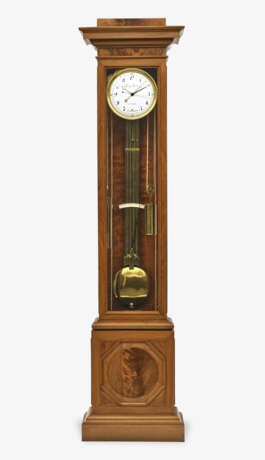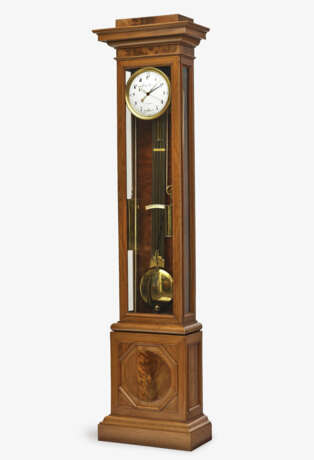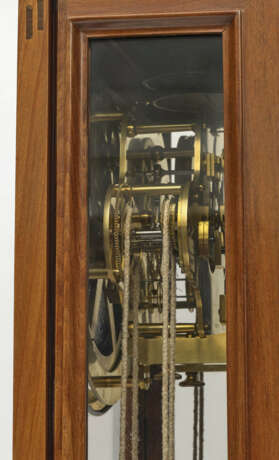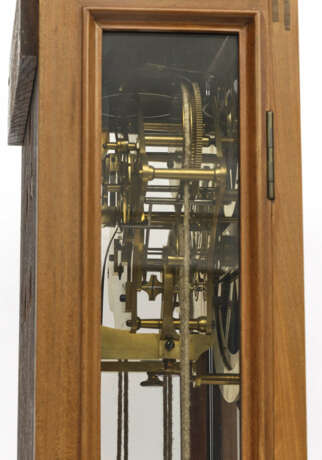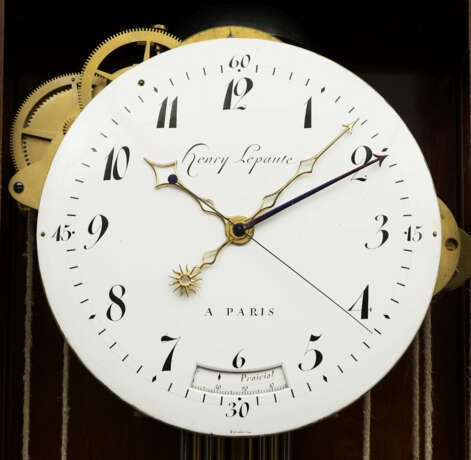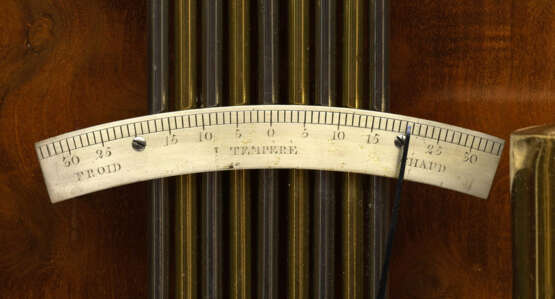Bodenstanduhr mit Äquationsanzeige und Republikanischem Kalender - Paris, um 1800-1805, Uhrwerk: Henry Lepaute à Paris. Emailleur: Dubuisson. Gehäuse: Charles Antoine Stadler
01.12.2021 18:00UTC +01:00
Classic
Starting price
210000EUR € 210 000
| Auctioneer | Kunstauktionshaus Neumeister |
|---|---|
| Event location | Germany, München |
| Buyer Premium | 30% |
Archive
The auction is completed. No bids can be placed anymore.

ID 671330
Lot 1127 | Bodenstanduhr mit Äquationsanzeige und Republikanischem Kalender - Paris, um 1800-1805, Uhrwerk: Henry Lepaute à Paris. Emailleur: Dubuisson. Gehäuse: Charles Antoine Stadler
Estimate value
€ 210 000 – 220 000
Messing, Email, Stahl, Mahagoni, Glas. Weiß emailliertes Zifferblatt mit schwarzen arabischen Stundenziffern, bezeichnet Lepautre und Dubuisson. Neunstäbiges Stahl-Messing-Rostpendel. Halbstunden- und Stundenschlagwerk auf zwei Glocken mit Schlossscheibe. Die Bodenstanduhr besteht aus einem gerade schließenden Korpus, der sich aus dem Sockel und dem mit dem Stempel des Ebenisten versehenen Uhrenkasten sowie dem auskragenden Abschlussgesims zusammensetzt. Das weiß emaillierte Zifferblatt mit seiner feuervergoldeten Rahmung, das neunstäbige Präzisionspendel, die Pendellinse, das Gewicht und die Thermometer-Anzeige sind durch das verglaste Gehäuse zu erkennen. Es gibt mehrere Zeiger: den vergoldeten Stundenzeiger sowie den gebläuten Stahlminutenzeiger und den goldenen Äquationsminutenzeiger. Hinzu kommt der dünne Sekundenzeiger. Bei der Ziffer 6 ist ein kleines Fenster zu erkennen, in dem der Republikanische Kalendermonat und das Datum abzulesen sind. Das Uhrwerk ist mit einer Lepaute-Scheren-Ankerhemmung versehen und das differo-epizyklische Äquationsgetriebe wird durch das schlossscheibengesteuerte Schlagwerk angetrieben. Der Rebublikanische Kalender begann mit dem 22. September 1792 und endete nach einem Dekret Napoleons I. am 1. Januar 1806. Die Besonderheit des Republikanischen Kalenders ist, dass alle zwölf Monate des Jahres gleichmäßig in je 30 Tage aufgeteilt sind. Fünf Ergänzungstage, die sog. ''Jours à Complet'' befinden sich zwischen dem Monat Fructidor (Fruchtmonat) und dem ersten Monat des republikanischen Jahres, dem Vendémiaire (Weinmonat, eine Erfindung des späten 17. Jahrhunderts). Die Äquationsanzeige verdeutlicht die Abweichung der mittleren von der wahren Sonnenzeit. Äquationsuhren besitzen daher zwei Minutenzeiger - im vorliegenden Fall ist der goldene Minutenzeiger mit Sonnensymbol der Äquationsminutenzeiger. Pierre-Henri Lepaute (1745-1805) hat das Uhrwerk hergestellt. Das Werk wie das Zifferblatt weisen seine Signatur auf. Er arbeitete u. a. für Louis XVI. und dessen Schwester Elisabeth. Zusammen mit seinem Onkel Jean Baptiste und seinem Cousin Pierre-Basile gründete er 1789 das Unternehmen Le Paute. Von Henri-François Dubuisson (aktiv 1769-1823) ist neben seinen verschiedenen Wohnadressen in Paris nur überliefert, dass er Zifferblätter und Uhrenboxen emaillierte. Charles Antoine Stadler war Ebenist und Schwiegersohn von Jean-François Leleu, der lange in der Werkstatt des hochangesehenen Pairser Ebenisten Jean-François Oeben tätig war. Leleu und er gründeten um 1780 ein gemeinsames Unternehmen und belieferten verschiedene Höfe mit ihren Möbeln. Nach Leleus Tod im Jahr 1807 führte Stadler Werkstatt noch bis 1811 weiter.
| Auction house category: | Clocks and Watches |
|---|
| Auction house category: | Clocks and Watches |
|---|
| Address of auction |
Kunstauktionshaus Neumeister Barer Str. 37 80799 München Germany | ||||||||||||||
|---|---|---|---|---|---|---|---|---|---|---|---|---|---|---|---|
| Preview |
| ||||||||||||||
| Phone | 089 231710-20 | ||||||||||||||
| Fax | 089 231710-50 | ||||||||||||||
| Buyer Premium | 30% | ||||||||||||||
| Conditions of purchase | Conditions of purchase | ||||||||||||||
| Business hours | Business hours
|
